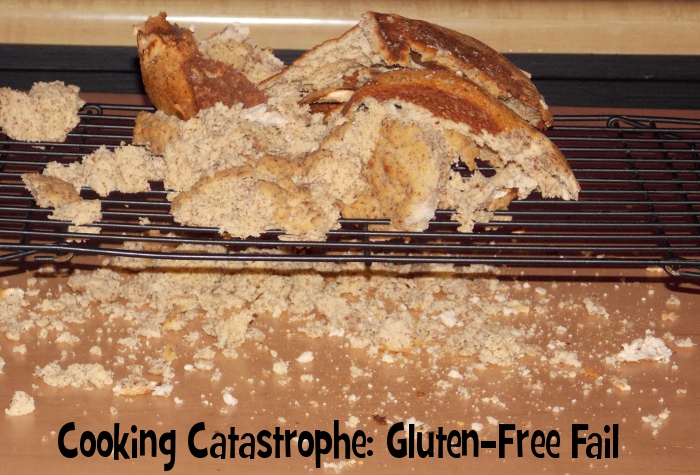
I totally thought I was on to a winner, you guys.
Back in 2010, I received a bag of coconut flour to test out, and I had wanted to make a loaf of bread with it. After doing a bit of Googling, I found that all the recipes were for loaves made by hand – none for a breadmaker, which is what I use primarily because it’s awesome and easy. Since I couldn’t find any bread machine recipes at all, I adapted one of my favorite breadmaker recipes to include coconut flour, and it was a resounding success; to this day, it’s one of my most-visited posts.
However, my recipe only uses partial coconut flour in conjunction with all-purpose flour. Flash forward to this June, when I attended a panel hosted by reality star Tenley Molzahn. Tenley has health issues that have led her to maintaining a gluten-free diet, and after the panel was over she stuck around to chat with attendees and answer questions about gluten-free living. Someone brought up coconut flour, and I had a chance to ask her about how I might create a gluten-free version of my coconut flour breadmaker loaf. Tenley had some great suggestions and recommended almond flour in place of the all-purpose flour, so when I got home from the conference, I ordered a few bags off Amazon.
This seemed like a brilliant idea: My original coconut flour recipe is years old at this point, from before I had a decent camera – heck, I’m pretty sure that post even pre-dates Pinterest. It was about time to update my recipe anyway, and I had grand visions of my beautiful bread, photographed with an angelic glow under summer sunlight. Plus, since this version would be gluten-free, my friends with dietary restrictions would be able to enjoy it, too! This was gonna be great!
So tonight, I made my recipe as normal, except this time I used 2 1/2 cups of almond flour in place of all-purpose flour. I put it in the breadmaker on “Bake Rapid”, and while it smelled great, it completely fell apart when the timer was up and I put it on the cooling rack. I thought, “Maybe it tastes better than it looks,” but no – it tastes awful, too! This happened to me the last time I tried to make coconut flour without gluten, although that time I used 100% coconut flour which was just asking for trouble.
I’m trying to figure out where I went wrong this time. Obviously, Tenley didn’t know what exactly was in my recipe – for all I know, I may have used way more almond flour than you’re supposed to. Or maybe it didn’t cook long enough, and I should avoid rapid bake mode? Or I’m missing something else?!
Gluten-free friends: Do you have any advice as to how I could make this recipe work without all-purpose flour? I have enough almond flour to try again, but since it’s expensive I’d hate to waste the rest of it on another flop!
Beeb Ashcroft
Latest posts by Beeb Ashcroft (see all)
- Starting Your Own Restaurant: Avoid a Catastrophe - May 14, 2019
- How to Become a More Productive Food Blogger – By Doing Less - April 2, 2019
- 5 Easy Keto Recipes - February 27, 2019









I wish I had advice. I am just now starting to bake from scratch more but totally using all purpose flour…. not sure how I would make anything that looked good without it. Hope someone can assist you with this.
I’m not sure if it will ever be super successful in the bread machine. I know that it seems like you needed a lot more eggs. Coconut flour is very absorbent. You need just 1/4 coconut flour for the all purpose flour you would normally use. You would need about 6 -10 eggs. Coconut flour is tricky but really good once you conquer it.
This is why GF baking TERRIFIES me. I am so glad I don’t have gluten-intolerance or I’d be in big trouble. 😉
Yikes!! Hopefully someone can help you out, I’ve been thinking about trying some GF baking but now i’m even more scared lol
I don’t have any advice unfortunately 🙁 I hope you find a successful recipe
Rachael – thanks so much for the great tips! And thanks to everyone else for the moral support! 😉